Use of a Semi-Explicit Probabilistic Numerical Model for Concrete Cracking: From Static to Dynamic Loadings
Abstract
1. Introduction
2. Numerical Models for Concrete Cracking in Statics and Dynamics
2.1. Cracking Model in Statics
2.2. Strain Rate Effect Related to the Uniaxial Tensile Behavior
2.3. Cracking Model in Dynamics
2.4. Finite Element Procedure
3. Numerical Applications
4. Results and Discussion
5. Concluding Remarks
- The dispersion of the numerical results related to the load–displacement curves globally decreases with the loading rate. This means that the global behavior of the structural element is very dependent on the material rate effects.
- The crack pattern changes a lot of with the loading rate (numerically and experimentally). This means that the structural inertia and the damping effect play an important role on the cracking pattern.
- Globally, the comparison between the experimental and numerical results (load–displacement curves and crack pattern) indicates an acceptable relevancy for the proposed numerical model.
6. Perspectives for Future Works
Author Contributions
Funding
Institutional Review Board Statement
Informed Consent Statement
Data Availability Statement
Conflicts of Interest
References
- Nilimaa, J.; Nilforoush, R. A direct tensile strength testing method for concrete from existing structures. CivilEng 2023, 4, 333–344. [Google Scholar] [CrossRef]
- Rossi, P. A physical phenomenon which can explain the mechanical behaviour of concrete under high strain rates. Mater. Struct. 1991, 24, 422–424. [Google Scholar] [CrossRef]
- Rossi, P. Dynamic behaviour of concretes: From the material to the structure. Mater. Struct. 1994, 27, 319–323. [Google Scholar] [CrossRef]
- Rita, M.; Rossi, P.; Fairbairn, E.; Ribeiro, F. Determination of the Probabilistic Properties of the Critical Fracture Energy of Concrete Integrating Scale Effect Aspects. Appl. Sci. 2024, 14, 462. [Google Scholar] [CrossRef]
- Rita, M.; Rossi, P.; Fairbairn, E.; Ribeiro, F.; Tailhan, J.; Andrade, H.; Mota, M. Three-Dimensional Probabilistic Semi-Explicit Cracking Model for Concrete Structures. Appl. Sci. 2024, 14, 2298. [Google Scholar] [CrossRef]
- Rita, M.; Rossi, P.; Fairbairn, E.; Ribeiro, F.; Tailhan, J.; Andrade, H.; Mota, M. Parallelization Strategy for 3D Probabilistic Numerical Cracking Model Applied to Large Concrete Structures. Buildings 2024, 14, 2327. [Google Scholar] [CrossRef]
- Rossi, P.; Wu, X.; Le Maou, F.; Belloc, A. Scale effect on concrete in tension. Mater. Struct. 1994, 27, 437–444. [Google Scholar] [CrossRef]
- Phan, T.; Tailhan, J.; Rossi, P. 3D numerical modelling of concrete structural element reinforced with ribbed flat steel rebars. Struct. Concr. 2013, 14, 378–388. [Google Scholar] [CrossRef]
- Nader, C.; Rossi, P.; Tailhan, J. Numerical strategy for developing a probabilistic model for elements of reinforced concrete. Struct. Concr. 2017, 18, 883–892. [Google Scholar] [CrossRef]
- Nader, C.; Rossi, P.; Tailhan, J. Multi-scale strategy for modeling macroscopic cracks propagation in reinforced concrete structures. Cem. Concr. Compos. 2019, 99, 262–274. [Google Scholar] [CrossRef]
- Rossi, P. Determination of Toughness Characteristics of Concretes. Curr. Trends Civ. Struct. Eng. 2023, 10, 1–7. [Google Scholar]
- Rossi, P.; Toutlemonde, F. Effect of loading rate on the tensile behaviour of concrete: Description of the physical mechanisms. Mater. Struct. 1996, 29, 116–118. [Google Scholar] [CrossRef]
- Rossi, P.; Van Mier, J.; Toutlemonde, F.; Le Maou, F.; Boulay, C. Effect of loading rate on the strength of concrete subjected to uniaxial tension. Mater. Struct. 1994, 27, 260–264. [Google Scholar] [CrossRef]
- Rossi, P.; Acker, P.; Francois, D. Measurements of the fracture toughness KIC of concrete. Fracture 1984, 84, 2833–2839. [Google Scholar]
- Rossi, P. Fissuration du béton: Du Matériau à la Structure-Application de la Mécanique Linéaire de la Rupture. Thèse de Doctorate, Laboratoire Central des Ponts et Chaussées, Paris, France, 1986. [Google Scholar]
- Rossi, P.; Coussy, O.; Boulay, C.; Acker, P.; Malier, Y. Comparison between plain concrete toughness and steel fibre reinforced concrete toughness. Cem. Concr. Res. 1986, 16, 303–313. [Google Scholar] [CrossRef]
- Rossi, P. Mode I Crack Propagation in Concrete Structures under Impact Loadings. Curr. Trends Civ. Struct. Eng. 2022, 9. [Google Scholar] [CrossRef]
- Ožbolt, J.; Sharma, A.; Reinhardt, H. Dynamic fracture of concrete–compact tension specimen. Int. J. Solids Struct. 2011, 48, 1534–1543. [Google Scholar] [CrossRef]
- Ožbolt, J.; Riedel, W.; Grunwald, C. Modelling the response of concrete structures from strain rate effects to shock-induced loading. In Understanding the Tensile Properties of Concrete; Woodhead Publishing: Sawston, UK, 2024; pp. 327–378. [Google Scholar]
- Ožbolt, J.; Bošnjak, J.; Sola, E. Dynamic fracture of concrete compact tension specimen: Experimental and numerical study. Int. J. Solids Struct. 2013, 50, 4270–4278. [Google Scholar] [CrossRef]
- Vegt, I. Concrete in Dynamic Tension: The Fracture Process. 2016. Available online: https://repository.tno.nl/SingleDoc?find=UID%20c7ed658d-0179-4d9c-9953-c449b37b151a (accessed on 27 June 2023).
- Bede, N.; Ožbolt, J. Effect of dynamic loading on concrete properties. In Numerički Postupci. Zbornik Radova Mini-Simpozija; Sveučilište u Zagrebu, Građevinski fakultet: Zagreb, Croatia, 2019; pp. 105–115. [Google Scholar]
- Gambarelli, S.; Ožbolt, J. Dynamic fracture of concrete in compression: 3D finite element analysis at meso-and macro-scale. Contin. Mech. Thermodyn. 2020, 32, 1803–1821. [Google Scholar] [CrossRef]
- Mosig, O.; Curbach, M. The crack propagation velocity as a reason for the strain rate effect of concrete: An analytical model. Civ. Eng. Des. 2020, 2, 123–130. [Google Scholar] [CrossRef]
- Ožbolt, J.; Sharma, A.; İrhan, B.; Sola, E. Tensile behavior of concrete under high loading rates. Int. J. Impact Eng. 2014, 69, 55–68. [Google Scholar] [CrossRef]
- Pedersen, R.R. Computational modelling of dynamic failure of cementitious materials. Ph.D. Thesis, Delft University of Technology, Delft, The Netherlands, 2010. [Google Scholar]
- Pereira, L.; Weerheijm, J.; Sluys, L. A new effective rate dependent damage model for dynamic tensile failure of concrete. Eng. Fract. Mech. 2017, 176, 281–299. [Google Scholar] [CrossRef]
- Ayhan, B.; Lale, E. Modeling strain rate effect on tensile strength of concrete using damage plasticity model. Int. J. Impact Eng. 2022, 162, 104132. [Google Scholar] [CrossRef]
- Zhou, W.; Tang, L.; Liu, X.; Ma, G.; Chen, M. Mesoscopic simulation of the dynamic tensile behaviour of concrete based on a rate-dependent cohesive model. Int. J. Impact Eng. 2016, 95, 165–175. [Google Scholar] [CrossRef]
- Knell, S.; Sauer, M.; Millon, O.; Riedel, W. Mesoscale simulation of concrete spall failure. Eur. Phys. J. Spec. Top. 2012, 206, 139–148. [Google Scholar] [CrossRef]
- Hao, Y.; Hao, H.; Zhang, X. Numerical analysis of concrete material properties at high strain rate under direct tension. Int. J. Impact Eng. 2012, 39, 51–62. [Google Scholar] [CrossRef]
- Costa, G.L.X. Modeling Dynamic Concrete Fracture with Applications to Petroleum Industry. Ph.D. Thesis, Federal University of Rio de Janeiro, Rio de Janeiro, Brazil, 2023. [Google Scholar]
- Costa, G.; Faria Telles, J.; Fairbairn, E.; Ribeiro, F. Thermo-chemo-mechanical analysis of concrete structures considering aging and damage. In Proceedings of the XLI Ibero-Latin American Congress on Computational Methods in Engineering, Porto, Portugal, 13–16 November 2020; Volume 2. [Google Scholar]
- Costa, G.; Brant, C.; Andrade, R.; Fairbairn, E. Finite Element Analyses of mesh-objectivity for Smeared, Damage and Discrete models applied to concrete cracking. In Proceedings of the XLII Ibero-Latin American Congress on Computational Methods in Engineering, Alagoas, Brazil, 11–14 November 2021; Volume 3. [Google Scholar]
- Brant, C.; Costa, G.; Andrade, R.; Fairbairn, E. Finite Element modelling of cracking in fiber-reinforced concrete beams. In Proceedings of the XLII Ibero-Latin American Congress on Computational Methods in Engineering, Alagoas, Brazil, 11–14 November 2021; Volume 3. [Google Scholar]
- Costa, G.; Brant, C.; Mota, M.; Andrade, R.; Fairbairn, E.; Rossi, P. Investigating spurious cracking in finite element models for concrete fracture. Comput. Concr. 2023, 31, 151–161. [Google Scholar]
- Rita, M. Implementation of a 3D Macroscopic Probabilistic Model for Semi-Explicit Concrete Cracking. Ph.D. Thesis, Federal University of Rio de Janeiro, Rio de Janeiro, Brazil, 2022. [Google Scholar]
- Ožbolt, J.; Bede, N.; Sharma, A.; Mayer, U. Dynamic fracture of concrete L-specimen: Experimental and numerical study. Eng. Fract. Mech. 2015, 148, 27–41. [Google Scholar] [CrossRef]
- Geuzaine, C.; Remacle, J. Gmsh: A 3-D finite element mesh generator with built-in pre-and post-processing facilities. Int. J. Numer. Methods Eng. 2009, 79, 1309–1331. [Google Scholar] [CrossRef]
- Ahrens, J.; Geveci, B.; Law, C.; Hansen, C.; Johnson, C. Paraview: An end-user tool for large-data visualization. Vis. Handb. 2005, 717, 50038-1. [Google Scholar]
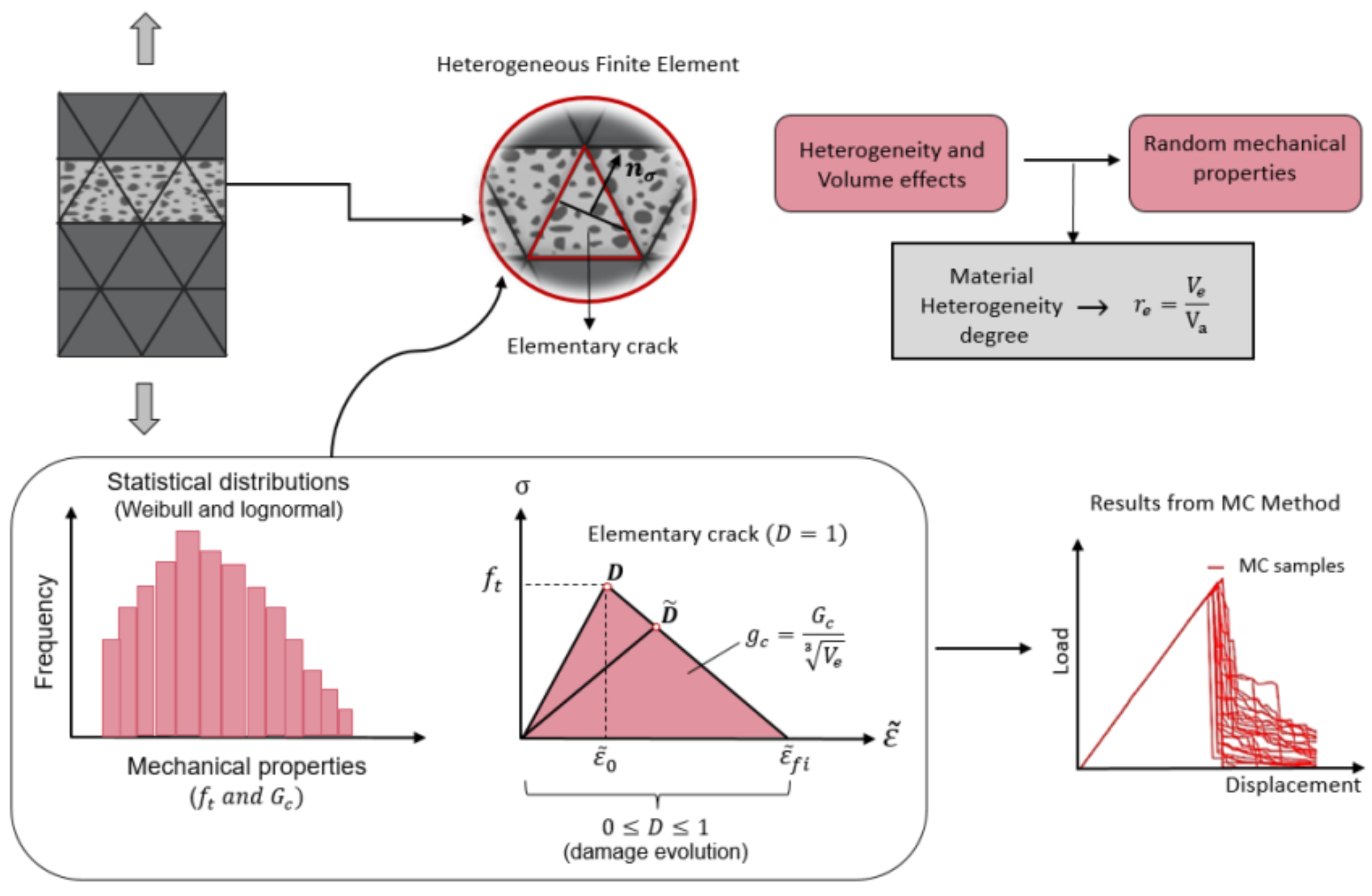

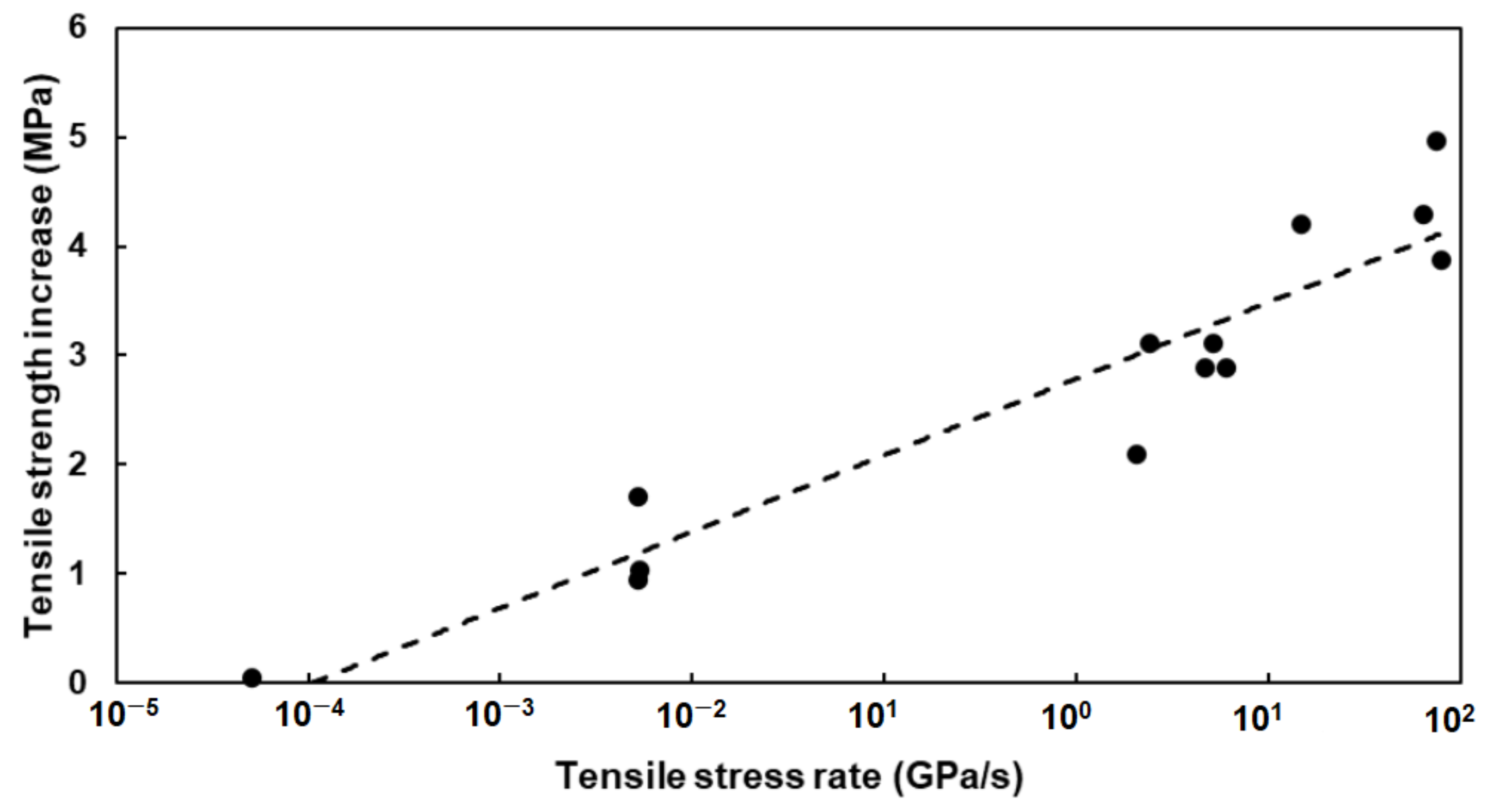
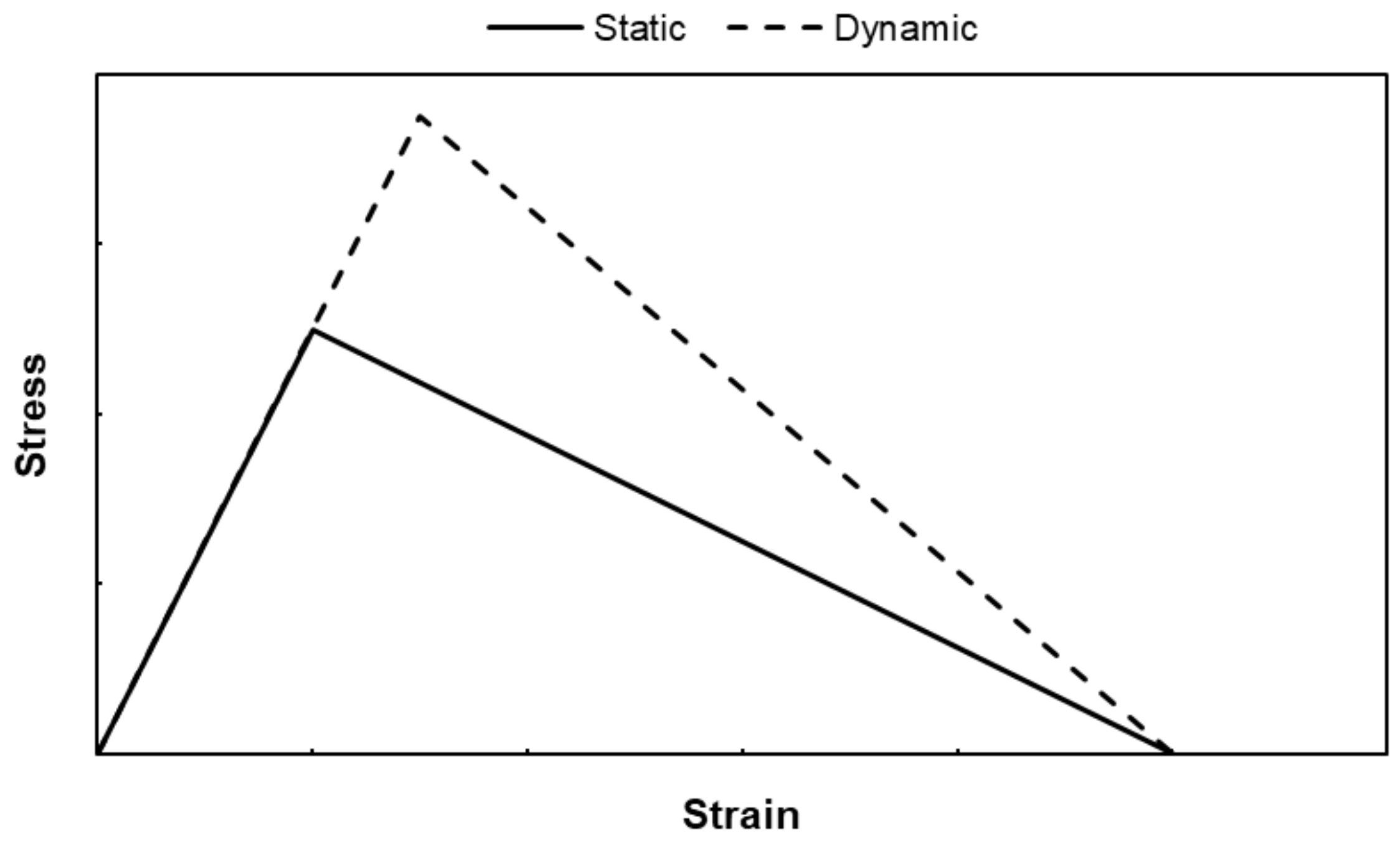
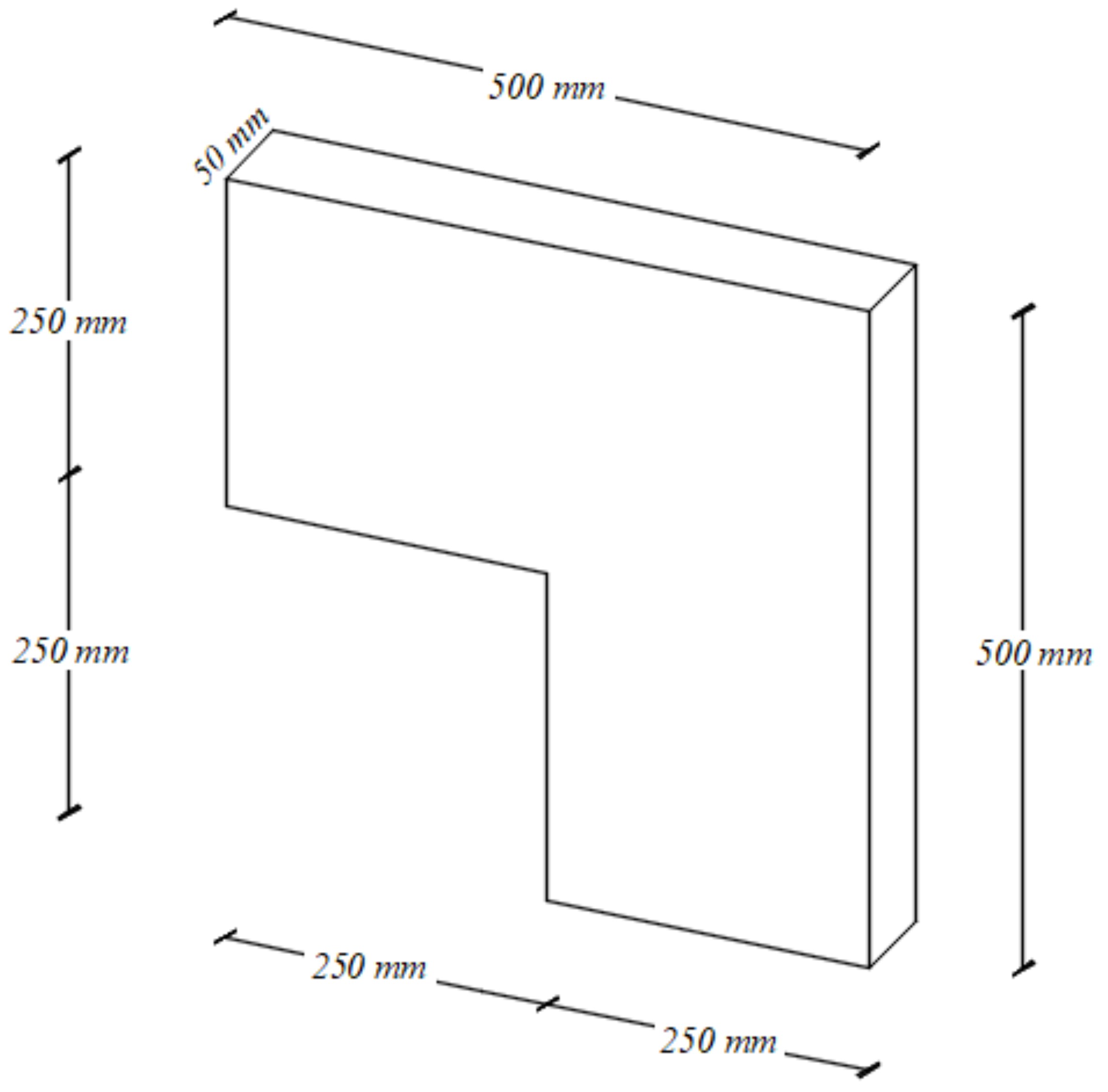

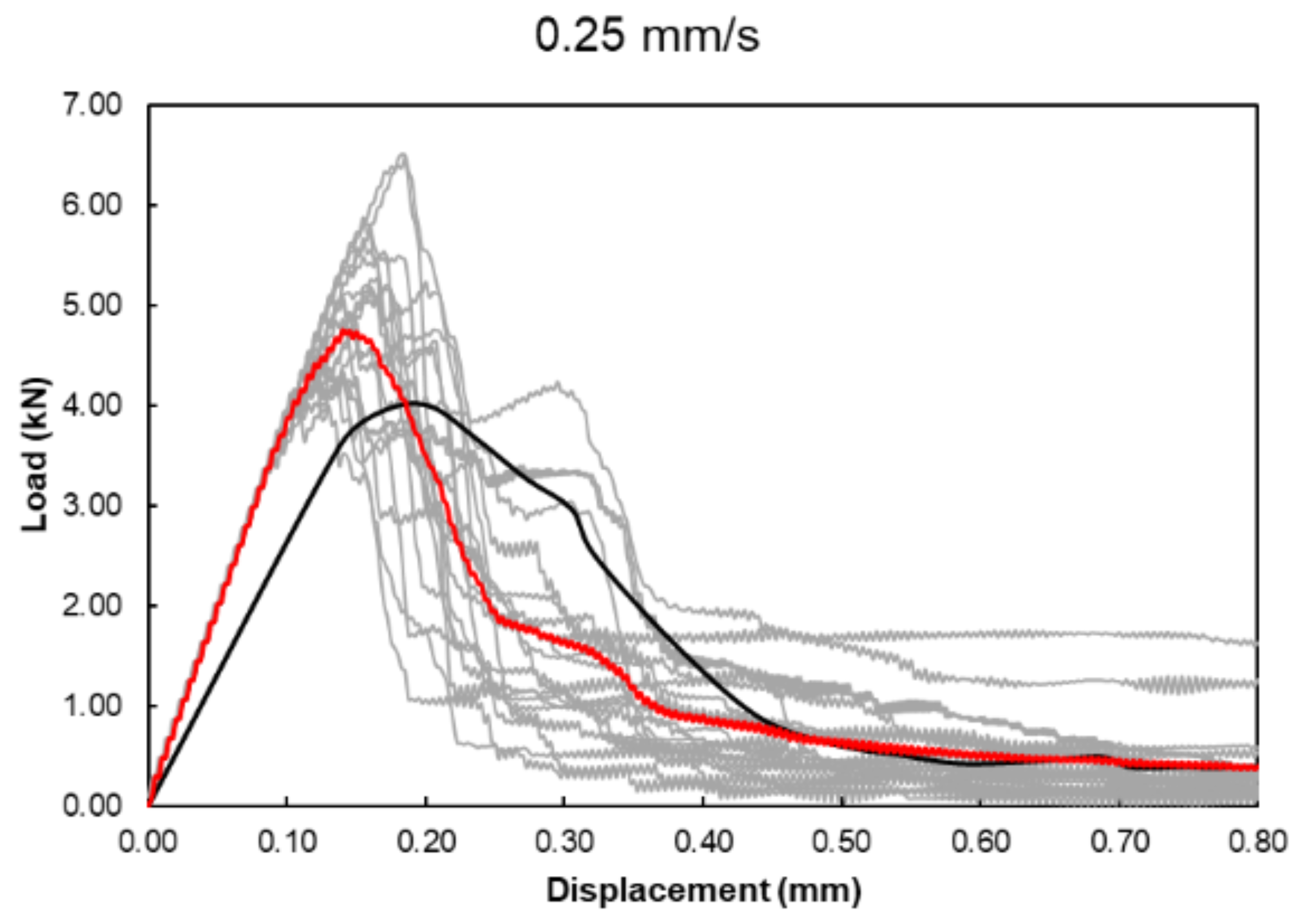

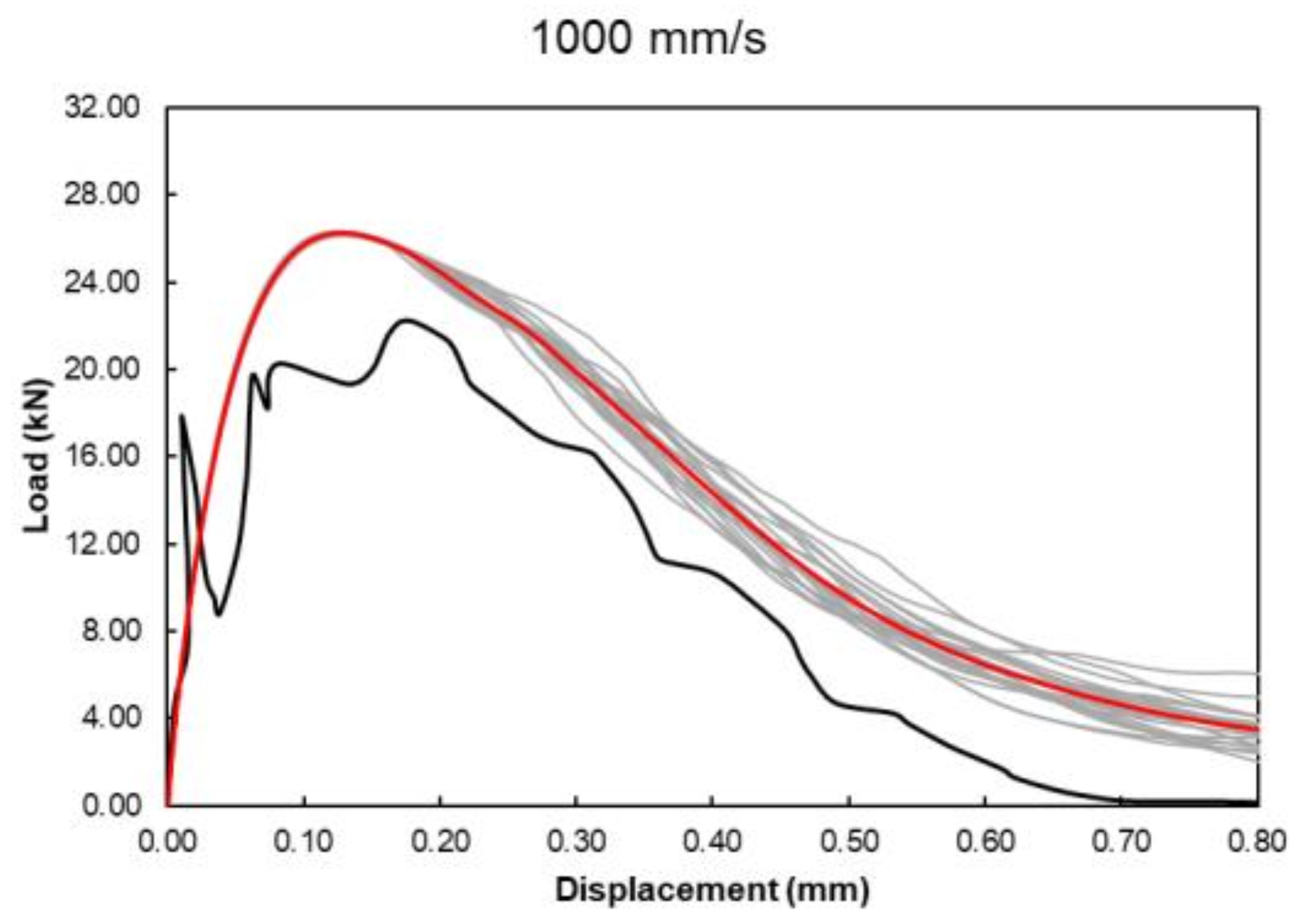




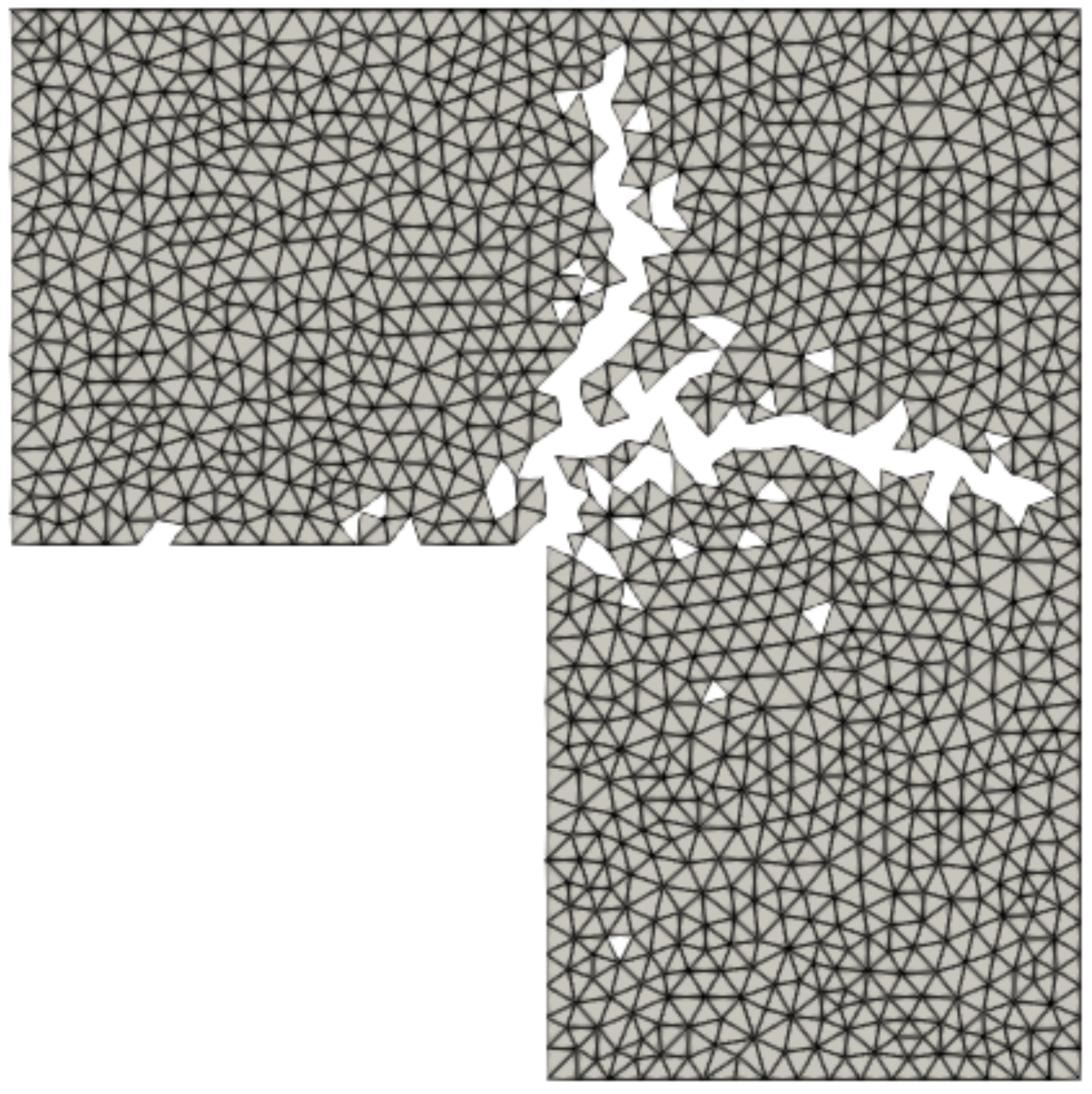
| Properties | Value |
|---|---|
| Maximum aggregate size, mm | 12.00 |
| Comp. strength, MPa | 46.25 |
| Elastic modulus, GPa | 32.20 |
| Poisson coefficient | 0.18 |
| Density, kg. | 2200.00 |
| Grav. acc., m. | 10.00 |
| Tensile strength | Probabilistic/rate-dependent |
| Tensile strength rate effect | |
| Fracture energy | Probabilistic/rate-dependent |
| , N. | 130.00 |
| Fracture energy rate effect | |
| Softening law | Linear |
| Equivalent strain | |
| Damage formulation | Scalar isotropic |
| Crack band width | |
| Element type | Constant Strain Triangle |
| Time increment, s | |
| (Newmark algorithm) | 0.25 |
| (Newmark algorithm) | 0.50 |
| Struct. damp. (Rayleigh) | |
| (Rayleigh damp.) | |
| (Rayleigh damp.) |
Disclaimer/Publisher’s Note: The statements, opinions and data contained in all publications are solely those of the individual author(s) and contributor(s) and not of MDPI and/or the editor(s). MDPI and/or the editor(s) disclaim responsibility for any injury to people or property resulting from any ideas, methods, instructions or products referred to in the content. |
© 2024 by the authors. Licensee MDPI, Basel, Switzerland. This article is an open access article distributed under the terms and conditions of the Creative Commons Attribution (CC BY) license (https://creativecommons.org/licenses/by/4.0/).
Share and Cite
Costa, G.; Rossi, P.; Rita, M.; Fairbairn, E.; Ribeiro, F. Use of a Semi-Explicit Probabilistic Numerical Model for Concrete Cracking: From Static to Dynamic Loadings. Appl. Sci. 2024, 14, 10643. https://doi.org/10.3390/app142210643
Costa G, Rossi P, Rita M, Fairbairn E, Ribeiro F. Use of a Semi-Explicit Probabilistic Numerical Model for Concrete Cracking: From Static to Dynamic Loadings. Applied Sciences. 2024; 14(22):10643. https://doi.org/10.3390/app142210643
Chicago/Turabian StyleCosta, Gustavo, Pierre Rossi, Mariane Rita, Eduardo Fairbairn, and Fernando Ribeiro. 2024. "Use of a Semi-Explicit Probabilistic Numerical Model for Concrete Cracking: From Static to Dynamic Loadings" Applied Sciences 14, no. 22: 10643. https://doi.org/10.3390/app142210643
APA StyleCosta, G., Rossi, P., Rita, M., Fairbairn, E., & Ribeiro, F. (2024). Use of a Semi-Explicit Probabilistic Numerical Model for Concrete Cracking: From Static to Dynamic Loadings. Applied Sciences, 14(22), 10643. https://doi.org/10.3390/app142210643






